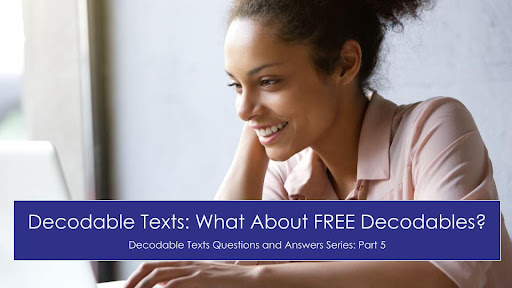Tax-free.
Gluten-free.
Free sample.
Free time.
Free shipping.
Free parking.
Who doesn’t love a freebie? We know we do!
And, if you love free stuff, then Part 5 of our “Decodable Texts: Question and Answer Series” is for you! Here we begin to tackle the question:
- What are some affordable (or better yet free) ways to get started exploring decodable texts?
If you’re like many educators we know, you’re likely feeling pressure to incorporate more decodable texts into your instruction, even if you only have limited decodable text options in your classroom collections (and all too often, you’re purchasing books out of your own pocketbook).
But we want to assure you that there are lots of affordable ways to get started with a shift to using more decodable texts. And all of the decodable texts you provide for your students don’t have to be full-color, professionally bound little books. Parts 5 and 6 of this series are all about affordable ways to get more decodable text in front of your young readers, starting immediately.
More specifically, in this post, we focus on FREE digital texts (some of them printable and some not) to help get you started.
So, what about FREE decodable texts and books?
Once you start looking, you might be surprised at how many FREE decodable texts are out there. Some of them – in our opinion – are high-quality. And some of them are just not so great. Of course, in the end, every teacher of children who are beginning decoders needs to learn to be discerning. (In case you missed it, our PART 3 and PART 4 in this series were all about evaluating the quality of decodable texts.)
We don’t know which texts will turn out to be the right match for you, your students, and your specific classroom context, but we have some options for you to check out in the bulleted list below. We share some free texts that we think are worth exploring.
Here’s a link to one we wrote for you, “A Pup Can,” which comes in a digital flipbook or a printable copy for kids to hold in their hands. We’ve also included the text on a single page for additional practice at home or school.
Daffodil Hill Press – Kids will love the storylines in these gorgeous little books. Adults will love the “Cheat Sheets” with information about decodability, HFWs, and conversation ideas all in one place. Diverse and relatable characters are sure to engage and delight. Several free and others for purchase.
Whole Phonics Readers – This is cool. Whole Phonics and ReadWorks have partnered to provide free decodable texts (from Whole Phonics) that are paired with knowledge-building passages (from Read Works) on topics related to the decodable, giving you connected ways to both build knowledge and offer students decoding practices. Check it out. Some of the decodable readers are free, and some are available for purchase.
Flyleaf Press – For a long time now, they have made their entire collection of Emergent Reading Series as well as Reading Series 1-3 available in digital form for free. These texts definitely have engaging stories and give kids things to think about and talk about. The sequence for the introduction of sound spellings in this series is a bit unique, but it’s definitely worth the work of seeing how these texts match your needs.
Core Knowledge – These are beautiful decodable texts that you can print or access digitally. In order to access them, you will need to share your email and a few other pieces of information. But in our estimation, these texts are worth the extra steps. Here’s how to get to the texts.
Follow the link above.
Select the Grade.
Select Language Arts.
Select Skills.
Then look for the texts that begin with the words Student Reader.
Beyond Decodables – These texts for beginning readers are written by Julia Lindsay, the author of Reading Above the Fray, in collaboration with the Boston Public Schools.
Half-Pint Kids – These are not printable, but you and your students can access and read them in digital format, and there is a generous array of titles.
Success for All – The special thing about these texts is that they are designed to be read in two voices: the voice of the beginning decoder and the voice of a more proficient reader. This structure provides specific decoding practice to the child while allowing the story and/or content to unfold in ways that aren’t possible only with a strictly controlled vocabulary.
Remember that “wish list” of decodable texts we encouraged you to make in PART 2 of this series? Well, we hope that as you study these and other decodable texts, you’ll find some that you just can’t wait to share with a particular student or group of students. And with each text you study, your confidence in noticing and naming the characteristics that matter will grow. It’s okay to be selective.
And don’t get us wrong. Although there are free resources available, we definitely advocate for school leaders to allocate budget resources for the purchase of high-quality decodable books for beginning decoders. This might mean committing to building a collection from the ground up. Or, it might mean continuing to supplement the resources you already have in order to fill identified gaps or shortages. Either way, decodable texts are necessary instructional resources that deserve a spot in a school’s budget planning.
But until all the resources you need are selected and purchased, you can take some time to explore these options. We’ll meet you back here for PART 6, which is all about using decodable sentences, paragraphs, and passages in fun and effective ways to provide more decodable text practice in whole group, small group, and independent practice. We hope to see you there.
Binge our entire 6-part blog series about decodable texts!
Decodable Texts Q&A (Part 1): What? Why? Who?
Decodable Texts Q&A (Part 2): How Many is Enough?
Decodable Texts Q&A (Part 3): What to Look For? The WORDS.
Decodable Texts Q&A (Part 4): What Else to Look For – The MEANING.
Decodable Texts Q&A (Part 5): What About FREE Decodables?
Decodable Texts Q&A (Part 6): More Ideas for Getting Started!
-

Jan Burkins and Kari Yates are authors, speakers, and consultants, who are dedicated to helping teachers around the world translate reading science into simple instructional moves that help teachers make learning to read easier for their students while still centering meaning-making, engagement, and joy.
Recent Posts


Lucy Calkinsand her colleagues offer free decodables on their website! They are adorable and free for all!
Where do you access them?
You should be able to follow the links in the post above.
Hello,
These suggested links are wonderful! One questions…are they suppose to be hyperlinks, because I cannot get them to work.
Thank you 🙂
Hi! Thank you for this wonderful list of free decodable texts. For some reason, the first 5 resources on the list don’t have clickable links. It looks like they are just a picture of the text and not the actual text, so there is no real link to click on. I’m especially interested in the decodable texts from Readworks and Whole phonics. Can you fix this? Thanks!
They should be working now! Enjoy!
Thank you for compiling and sharing this information. The first 5 hyperlinks are not clickable for me and seem to be formatted as a picture instead. Is it possible to correct this and reshare it?
Thanks for letting us know. They should be working now!